Well-being & Ecology _|_ Issue 24, 2023
Eating the Wild
Charlotte Maberly investigates the benefits of foraging, and talks to Scottish food writer and historian Fi Martynoga


Eating the Wild
Charlotte Maberly investigates the benefits of foraging, and talks to Scottish food writer and historian Fi Martynoga
In recent decades, and especially since the Covid-19 pandemic, there has been a growing interest in foraging and cooking with food gathered from the countryside around us. In this article, Charlotte Maberly talks to the distinguished Scottish food writer Fi Martynoga about the benefits of eating wild food, and also looks at the history of the movement and its wider implications in terms of health, food justice and food insecurity. An important aspect of the contemporary movement is its potential to reconnect us with the natural world and change our relationship with it.
 In the spring of 2023 the UK was warned to expect shortages of fresh fruit and vegetables in major supermarkets. The news felt incongruous with the season as the landscape was bursting with new growth. But the Russia–Ukraine conflict has revealed the complex nature of supply chains, with everything from fuel to fodder, building materials and many other commodities being affected. Disruptions to food supply are inevitably the most unsettling. For most people in the developed world today, food scarcity is a forgotten problem. For decades we have received a comforting message of consistent abundance from full supermarket shelves. But this has hidden the true fragility of our food system. In fact, less than half of food eaten in the UK today is produced in the country, creating vulnerability within a complex infrastructure shaped by logistics, increasingly capricious weather, and of course, the politics of trade (see the UK Food Security Report [/]).
In the spring of 2023 the UK was warned to expect shortages of fresh fruit and vegetables in major supermarkets. The news felt incongruous with the season as the landscape was bursting with new growth. But the Russia–Ukraine conflict has revealed the complex nature of supply chains, with everything from fuel to fodder, building materials and many other commodities being affected. Disruptions to food supply are inevitably the most unsettling. For most people in the developed world today, food scarcity is a forgotten problem. For decades we have received a comforting message of consistent abundance from full supermarket shelves. But this has hidden the true fragility of our food system. In fact, less than half of food eaten in the UK today is produced in the country, creating vulnerability within a complex infrastructure shaped by logistics, increasingly capricious weather, and of course, the politics of trade (see the UK Food Security Report [/]).
Historically, shortages in the spring were actually quite normal. Across Britain, April and May were long known as the ‘hungry gap’, when winter stores were depleted but the garden was not yet producing. Then, as in much of northern Europe, people would ritually turn to the wild, drawing on inherited knowledge passed from generation to generation over thousands of years.
These days wild harvests are seldom considered to be a viable method of food procurement. But given that adaptability is going to be the key to our survival in the face of climate change, I wondered whether this was something we should or could take more seriously. So I decided to have a talk with Fi Martynoga, a writer and historian with a deep knowledge of wild food usage. In discussion, it became clear that food security was only one of many good reasons why we should pay closer attention to our edible landscape.

Fi at her cottage in Traquair, Scotland. Photograph: Scottish Local History [/]
Understanding the Hungry Gap
To meet with Fi, I travelled to Traquair, a picturesque corner of the Scottish Borders, to visit her at her home. She met me in the garden before taking me into her flagstone-floored and distinctly chilly kitchen. She apologised that the wood-fired Rayburn would not be lit until she came to cook her evening meal and hoped that I did not feel the cold. Knowing she is made of sterner stuff than myself, I chose to keep my coat on. We sat at a long, heavy wooden table and whilst we talked she produced a hearty nettle soup, cheese board, and spiced wild garlic paste. The food felt deeply nourishing, evocative of the vital spring growth outdoors, and was also a perfect accompaniment to our discussion.
Fi is respected for her knowledge of Scotland’s wild harvest traditions, and as a writer who has seriously interrogated our interrelationship with the natural world. She is perhaps most widely known for having completed a challenging experiment in self-sufficiency. For a whole year, she moved out of her house and into a stone byre where she chose to live in the manner of one of her eighteenth-century ancestors. “I was researching for an exhibition on the history of food in Scotland and discovered that our diet had deteriorated since agricultural improvements of the late eighteenth century. Until then, people had been living on a simple diet, probably rather boring, but wholesome. Then in a relatively short period of time, we became the greatest sugar eaters in Europe, with health concerns to match. It made me quite angry and I wanted to find an engaging way of drawing attention to it.
“I put myself back to a time before mass production, even using vessels made of wood, bone and horn. My food came from the garden with a few bought inputs like barley-meal and oatmeal. I avoided anything that wouldn’t have been in that mid-eighteenth-century diet. And in spring I discovered how important foraging was. I’d always done it but when you rely solely on your garden vegetables the hungry gap leaves you with almost nothing. But right at that time nettles and wild garlic arrive, and that focussed me. I really understood that human survival has been intimately linked to our knowledge of wild foods. But in the eighteenth century, most people moved into cities, or were forced to work for landowners. Leisure time became rare and traditional practices like foraging and wild crafts all but died out.”
Fi’s experiment caught the imagination of her readers precisely because such a lifestyle is almost unrecognisable today. In only a few hundred years, wild food has changed from being an unquestioned necessity to being interesting or eccentric, controversial and even unethical. But Fi has been pursuing an understanding of human–plant interrelations since she was very young. She grew up in a town but her father took an avid interest in plants. “There was always something we were gathering”, she remembers, recounting his enthusiasm for making wild wines, preserves and crafts. “These experiences make you realise that there is such potential out there”.

‘Hungry gap’ foods found in the garden. In the basket is sweet cicely and wild garlic. On the ground are cleavers nettles and ground elder. Photograph: Charlotte Maberly
Weeds or Wild Food?
Fi has continued to develop her own informed relationship with the natural world ever since. Gathering from the wild is almost a daily practice – “It’s an unusual walk when I don’t nibble something!” – and she has shelves of dried herbs for tea as well as a freezer full of wild greens. “Collecting food this way is a pleasure, unlike going to the supermarket, and is often a social activity for me – a good opportunity to learn and share this fascinating world. But most of all, foraging just feels like common sense.”
She explains that once you know how to identify plants, you see that wild food – which comprises anything edible not formally grown – is freely available almost everywhere. It could even include ‘weeds’ growing in your own garden, or nearby wherever you live. “If I choose to eat Japanese knotweed, that’s a wild food, even though it’s a horrible invasive!” Her desire for a ready supply has led her to encourage certain weeds, like sweet cicely, wild garlic and nettles – ‘the bedrock of things’ – to grow in her own garden, albeit at a suitable distance from her vegetable beds.
Another major benefit is that wild food, as long as it is selected carefully, can be free from potentially harmful chemicals used in agriculture. Recent studies have shown that commercially grown food may have lost over half of its nutritional value over the last century while wild food remains nutrient and mineral rich.[1]
As we finished up our lunch, I asked for her thoughts on whether we could ameliorate the impending salad shortage with wild foods. “Loads more people could forage, but if there was a lasting shortage of commercially grown food then it would become a challenge to feed everyone due to the sheer number of people alive now. But before we even get to that stage, the biggest barrier is the relatively modern story that nature is dangerous and dirty. The British love their countryside, but they want to look at it, rather than touch it or eat it. And most of us live in towns and cities now, which means we don’t have a lot of opportunity to interact with our view. The closer you live to the earth the more you use it – and have to.”
In 2006, a Forestry Commission study [2] showed that around a quarter of the Scottish population are still gathering something from the wild. “But that ‘something’ is always blueberries or brambles,” says Fi. “The percentage of the population who practice will have declined by now, even after the renewed interest in foraging. It is still a minority activity in the UK, especially when you compare us to other countries. But it is so important that we don’t forget how to do it, as it is a vital link to our past and our present countryside.”
This is what motivates Fi to pass on her own knowledge. Alongside her first book of wild harvests, Fi has also co-written books on Scotland’s trees, and seaweeds, and she also writes regularly for the magazine Re-Foresting Scotland [/].

The elder tree (Sambucus nigra) was traditionally known as the ‘medicine tree’ because all its parts can be beneficial if used correctly. Lithograph in Robert Bentley and Henry Trimen’s Medicinal Plants, London, 1880. Image: Album / Alamy Stock Photo
Move computer mouse over image to enlarge
Foraging Manuals
In the absence of a thriving practical or oral tradition, writing about wild plants and their uses has been invaluable at different points in history, particularly whenever there has been significant social or ecological disruption. In the late 17th century, Sir Robert Sibbald (1641–1722), co-founder of the Edinburgh physic garden (now the Royal Botanic Gardens of Edinburgh), published what is now fondly referred to as one of the first ‘foragers manuals’: Provision for the Poor in time of dearth and scarcity Where There is an Account of Such Food as may be Easily Gotten When Corns are Scarce.[3]
He aimed to record the most useful ‘famine foods’ (common native plants and animals that persist when agricultural crops fail) as he believed that knowledge of them was in decline. This was not an enterprise born of nostalgia, but a response to crop failures that had swept Scotland as much as in Ireland. Sibbald, and many others, recognised that people may have been spared from famine had they known about the plentiful wild food around them.
In the twentieth century there was another revival of interest in foraging, led by Richard Mabey’s 1972 book Food for Free.[4] In this Mabey pointed out that we are overlooking a significant domestic resource: ‘There are at least 320 wild food products growing in this country… 130 of which are common throughout the British Isles.’ [5] Mabey’s book became a much-loved classic, providing illustrations, descriptions and culinary uses of Britain’s plants, shellfish and fungi, along with guidance for sustainable harvesting. Like Sibbald, he was uneasy about the ramifications of knowledge loss, but future food security was not his only motivation for documenting nature’s larder. He was also concerned that all food was becoming detached from its origin in nature, saying:
… it is difficult to believe that some of these products actually grew, so perfect are their proportions… not only are we ‘cut off’ from a knowledge of wild foods, but at a more fundamental level from a first-hand knowledge of what food is, and how it gets to us.[6]
Mabey wrote Food for Free in the wake of the ‘green revolution’ when rapid advancement in agricultural technologies, such as chemical pesticides and fertilisers, saw the largest harvests ever recorded. With it rose a hope that global poverty and starvation were at an end. And it is true that it did bring positive and significant change across many areas of human life. But it also introduced an unprecedented complexity into the agricultural sector and wider food system. The food chain expanded to include industries such as mineral mining and trading, and chemical manufacture.
However, ten years earlier a deeply influential book had sown a seed of unease that was coming to fruition. Silent Spring by Rachel Carson [7] outlined what many could not yet see – that pesticide use in the name of food production was permanently damaging the environment. This, along with events such as the Santa Barbara oil spill in the early 1970s, spurred many people to investigate a lifestyle less reliant on chemicals and fossil fuels. The notion of living closer to the land became desirable, and in the latter half of the decade the popular TV comedy The Good Life tapped into the ideals of many. At that key moment, Mabey’s work represented an ultimate return to the land and provided food for thought that continues to inspire people to try foraging, particularly in times of uncertainty.
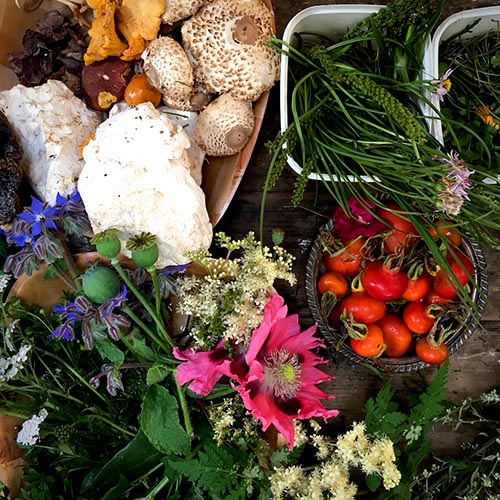
An early autumn harvest of edible and medicinal plants, including chanterelles and other wild mushrooms, sea asters, rosehips, sweet cicely, meadowsweet, yarrow, woodruff and borage. Photograph: Charlotte Maberly
The Stories Plants Tell
Fi’s own contribution to the canon of written manuals came in 2012 with A Handbook of Scotland’s Wild Harvests,[8] a book specifically about Scotland’s flora and wild traditions. It is a collaboration between several wild food and craft experts, focussing on the most common edible and medicinal plants and fungi, as well as basketry and other wild crafts. It does not aim to be a comprehensive reference book but illustrates the ways in which wild plants have been part of our culinary and medicinal lexicon for millennia. “It’s so important that people learn to really look at and be curious about nature. But there is no incentive to do that if nature is just an indistinguishable green mass. Wild foods, and the wonderful stories behind their usage, are a very good way of grabbing people’s imagination. When they find they can create something nourishing or delicious with a plant, then they begin to seek it out in the wild and develop a relationship with it.”
Fi’s book indicates that although many key edible species have not changed for hundreds, if not thousands, of years, our attitude and understanding of them has. Nettles and ground elder, for example, are two of the UK’s most ubiquitous weeds but are not widely eaten. These common plants have followed human settlement for millennia, providing medicine, food and even fibre. Ground elder, ubiquitous in most gardens today, was kept as a pot herb by the Romans and used as we might use parsley. Today’s gardeners may not forgive them for bringing it to this country, but in more recent centuries it was valued for its ability to counter over-consumption and earned the name ‘gout-weed’.
The Romans also used nettles in a way we might no longer appreciate, beating their bare backs and joints to alleviate arthritis. Nettle is now known to contain a powerful antihistamine and many attest that it can help reduce swelling and irritation, including eczema. Nettle stalks have long been used to make rope and netting, as well as fibre for clothing, and there is evidence that soldiers in the first world war wore items made out of it. Scottish Highlanders believed that you must eat seven meals of nettle in the year, and given that it contains concentrated levels of vitamins and minerals and appears at the end of the winter when we most need a boost to the immune system, this seems quite a sensible ritual.
In fact, the effectiveness of many traditional remedies, along with a greater public desire for ‘natural’ products, has encouraged pharmaceutical companies to create products previously only made in country kitchens. For instance, the various products of the elder tree, once known as ‘nature’s medicine cabinet’, are still sought by even the most amateur foragers in spring to make elderflower cordial, and again in autumn for the deep purple berries which make a wonderfully rich liqueur. They are less likely to be aware that all parts of the elder – including the bark and the leaves – offer potent medicine if used correctly. In fact, the plant is now cultivated to make an immunity-boosting elderberry syrup which is available in most chemists.
But whilst commercial production can bring the benefits of the ‘wild’ to many, the physical interaction with these plants that we gain through foraging has more than just a physiological effect. As Mabey attests:
Getting to know these plants and the uses that have been made of them is to begin to understand a whole section of our social history. The plants are a museum in themselves, … living record of famines and changing fashions and even whole peoples. To know their history is to understand how intricately food is bound up with the whole pattern of our social lives.[9]
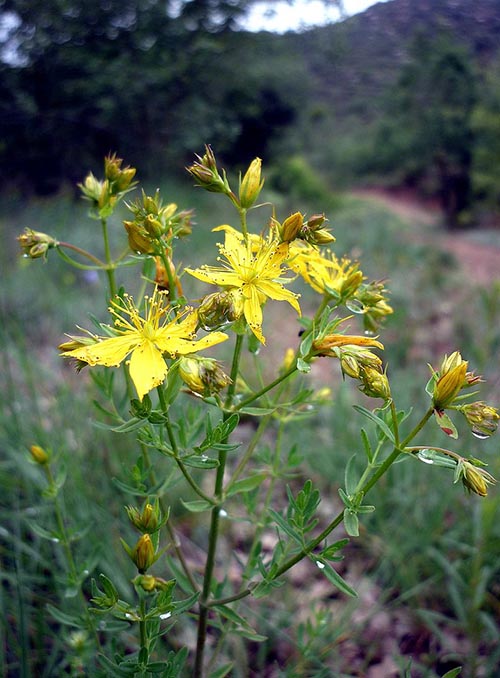
St John’s Wort (Hypericum Performatum) grows wild throughout Europe and Asia. It has been used in traditional medicine since at least the first century AD, often as a cure-all or panacea. In modern times, its use as an antidepressant has been the focus of numerous studies but it needs to be used with caution. Photograph: advicefromtheherblady [/]
Changing Attitudes: the Business of Nature Connection
Wild foods may not have played a strong role in British life and diet for centuries, but in other countries – such as France, Bulgaria, and most Scandinavian countries – the practice has never really waned. The vast majority of wild plants used to make the medicines, teas and cosmetics available on UK shelves actually come from countries where professional foraging is still common. For instance, in her recent best-selling book, Elixir: In the Valley at the End of Time,[10] Kapka Kassabova documents the astonishing knowledge retained amongst the people of the Mesta Valley region in Bulgaria, who collect culinary and medicinal plants which are sold into a thriving international market.
Kassabova highlights the injustice that, despite the dangers and hardships implicit in the work, these foragers are rarely paid well, and their part in the product is obscured from the moment it leaves their hands. She comments on the irony that UK customers rely heavily on the traditional knowledge of others and are willing to pay high prices for the products when many of the ingredients are available for free on their own doorsteps.
But attitudes are perhaps changing, as the concept of nature connection – and our apparent lack of it – seems to have grasped the national attention. Alongside hundreds of nature and environment themed publications, numerous foraging manuals and wild recipe books have appeared in the last decade. Some market monitors report that the Covid pandemic instigated a 90% increase in the appearance of wild food-related content on social media. This does not necessarily translate into practice but could arguably be an indicator of changing attitudes and potential behavioural change. The appetite for wild foods supports thousands of foraging blogs, podcasts and social media accounts [search #foraging or #wildfood on any platform]. And in mainstream media, Hugh Fearnley-Whittingstall and Chef Nick Nairn have led a troupe of enthusiastic celebrity chefs out of the kitchen and into the woods. Foraging courses and retreats are now offered up and down the country, and there is even an entire weekend-long wild food festival in Scotland [/].
Of particular note is the renowned UK forager, Monica Wilde, whose recently published book The Wilderness Cure: Ancient Wisdom in a Modern World documented her experience of eating only wild food for a year.[11] Like Fi’s experiment, this makes for a compelling read precisely because it is so out of the ordinary. Monica surprised her urban readership by revealing that it was not possible to survive the year as a vegetarian. But this is not really surprising, comments Fi, as conventional food production actively reduces botanical diversity in our landscape, and unchecked deer and rabbit populations further deplete wild plant species. They do, however, provide potential meat.
Fi celebrates projects such as Monica’s, and sees them as a form of environmental education. “The more you forage, the keener your observational skills become. You begin to recognise which plants grow together, you notice habitat, ground conditions, all sorts. Over time you learn much more than just what is edible. You gain an intuitive sense of how nature works and how you work within it, and perhaps most importantly today, how you can be a positive influence within it.”
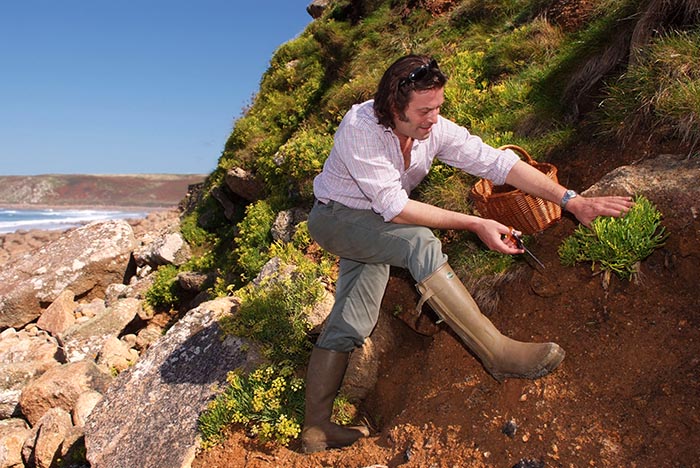
Chef Matt Williamson foraging for rock samphire, also called sea fennel, in Sennen Cove, Cornwall. Photograph: Christopher Jones / Alamy Stock Photo
Conserving Nature
This aspect of reconnection takes on great importance in our contemporary context, when we need to be developing more sustainable ways of life. A key member of the UK Foraging Association, John Wright, has written numerous books about wild food and is keen to present modern foragers as conservationists. ‘Searching for wild food has a powerful effect on how people see the natural world. They suddenly find themselves a part of it, rather than merely an onlooker. Foraging immerses us in the world, and we come to know it, love it – and to seek to protect it.’ [12]
Some people disagree. With the growing demand for wild food on restaurant menus, reports have emerged of renegade gangs leaving woodlands damaged and depleted in the pursuit of valuable mushrooms and berries. And a horrified public appears ready to consider foraging an irresponsible pastime in the context of our environmental crisis.
Mark Williams of Galloway Wild Foods [/] has been keen to take part in the debate, and is adamant that such acts of vandalism are both rare and often sensationalised. But recognising that knowledge of how to harvest responsibly and sustainably – an essential foundation in indigenous societies which rely upon wild foods – has been largely lost on our culture, the various foraging organisations have developed clear guidelines for gathering from the countryside. These can be summarised as four golden ‘foraging rules’:
1. Harvest only 1 in 20
Leave much more than you take, only take what you will eat, stick to abundant species and do not pick rare plants.
2. Be 100% sure
Only harvest what you can identify with complete certainty. Learn plant identification skills from guidebooks and an experienced forager before you start harvesting your own.
3. Know the law
Know when, where and what you can forage by checking land use rights for your area. Guidance is widely available online.
4. Tread lightly
Don’t cause damage by overharvesting, uprooting plants or disrupting surrounding habitat.
Williams feels that foraging only appears environmentally damaging to those with a guilt-laden belief that we have ‘used up’ all the wild land and that the only responsible action is to remove ourselves from nature so it can ‘heal’. This attitude only further prevents us from cultivating our relationship with nature. Richard Mabey made the same point over fifty years ago: ‘One of the major problems in conservation today is not how to keep people insulated from nature but how to help them engage more closely with it.’ [13]
In fact, eating nature may be the best and most accessible method we have of creating bonds with it. Accepting something as food means we choose to open the boundary between external and internal – to, quite literally, incorporate the world. The act of eating immediately and viscerally exposes our vulnerability as humans, making it an opportunity for profound connection, as John Wright says: ‘Hunters and gatherers. That is what we are, and nature rewards us, not just in the food these pursuits provide but also in the more fundamental form of rewarding our souls.’ [14]
Perhaps foraging for our supper will not become everyday practice for most of us, but Fi feels hopeful that a steadily growing number of people will seek out the flavours and experiences of the wild at least some of the time.
Why wouldn’t more people do it? You can find more nutritious, interesting and delicious food than in a supermarket, it’s free and great exercise! And then every time you forage you learn something new, and can make that bond with nature even stronger.

Wild food feast: from top to bottom: nettle and goats cheese frittata, roman peas cooked with garam and ground elder, wild garlic pesto with tomatoes and fresh curd cheese, blood orange salad with sweet cicely. Photograph: Charlotte Maberly
For more complete guides to foraging sustainably, safely and legally, visit:
The Association of Foragers has information for and by UK foragers (click here).
The Woodland Trust also has a simple sustainability guide (click here) whilst the Botanical Society of Britain and Ireland offers comprehensive legal and environmental guidance (click here).

Charlotte Maberly is a freelance writer interested in the interconnections between people, place and nature. Read more at FoodConnects.net
Image Sources (click to close)
Banner: Fi Martynoga (left) and fellow foragers gathering rosehips in the autumn. Photograph: Charlotte Maberly.
Inset: Elderberries. Photograph: Wikimedia Commons
Other Sources (click to open)
[1] ANNE-MARIE MAYER, et al., ‘Historical changes in the mineral content of fruit and vegetables in the UK from 1940 to 2019: a concern for human nutrition and agriculture’, in International Journal of Food Sciences and Nutrition (2021). Available in PDF version here [/].
[2] MARLA EMERY, et al., Wild harvests from Scottish woodlands: social, cultural and economic values of contemporary non-timber forest products. (Forestry Commission, Edinburgh. 2006) pp.i–viii + 1–40. Available in PDF version here.
[3] SIR ROBERT SIBBALD, Provision for the Poor in time of dearth and scarcity Where There is an Account of Such Food as may be Easily Gotten When Corns are Scarce. (James Watson, 1699).
[4] RICHARD MABEY, Food For Free: a guide to the edible wild plants of Britain. (William Collins Sons and Co, Glasgow. 1972).
[5] MABEY, p. 10.
[6] MABEY, p. 9.
[7] RACHEL CARSON, Silent Spring. (Houghton Mifflin, 1962).
[8] FI MARTYNOGA, et al, ed. A Handbook of Scotland’s Wild Harvests: the essential guide to edible species with recipes and plants for natural remedies and materials to gather for fuel, gardening and craft. (Saraband, UK. 2012).
[9] MABEY, pp. 14–15.
[10] KAPKA KASSABOVA, Elixir: In the Valley at the End of Time.
[11] MONICA WILDE, The Wilderness Cure: Ancient Wisdom in a Modern World. (Simon and Schuster, UK 2022).
[12] JOHN WRIGHT, River Cottage Handbook, No. 7: Hedgerow. (Bloomsbury, London. 2010) p. 10.
[13] MABEY, p. 15.
[14] JOHN WRIGHT, River Cottage Handbook, No. 7: Hedgerow. (Bloomsbury, London. 2010) p. 9.
FOLLOW AND LIKE US
——————————————
——————————————
——————————————
FOLLOW AND LIKE US
If you enjoyed reading this article
Please leave a comment below.
Please also consider making a donation to support the work of Beshara Magazine. The magazine relies entirely on voluntary support. Donations received through this website go towards editorial expenses, eg. image rights, travel expenses, and website maintenance and development costs.
READ MORE IN BESHARA MAGAZINE
Cooking in the Ainu Way
Artist Eiko Soga talks about her experience of living with the indigenous people of Japan
Redescovering Our Earth Emotions
Environmental philosopher Glenn Albrecht talks about climate change, solastalgia and his inspiring vision for the future
The Healing Power of Plants
Anne McIntyre on the Western and Eastern traditions of herbal medicine, and their importance in the contemporary world
The Unity of Bee-ing
An interview with Heidi Herrmann about the work of The Natural Beekeeping Trust in preserving our precious population of bees
READERS’ COMMENTS

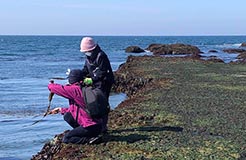
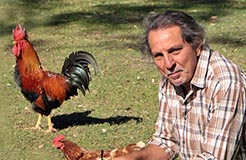
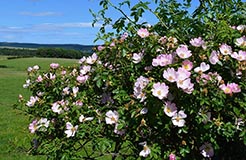

What we must realize and acknowledge is that climate change threatens such wild foraging in the same way it does all of life on this planet. I grew up foraging for many things wild, back then it was rampant development that took away habitat and wild places, “edge” we ecologists called it. Now my own elderberries and blackberries along with wild radishes, mustard, onions and so much more are threatened even where habitat has been preserved. We have much work to do if we would save the planet. And much of the “work” is giving up our grip on the comforts we become accustomed to.